MERCHANT AND ESTATE OWNER
The Wandborg Family at Kabbel in the 18th Century
By Ellen Damgaard, Lemvig Museum.
Kabbel Manor tells two stories. One is about enterprising west Jutland mercantile families, who assume the role of estate owners with a flair for the necessary investment and a beady eye on the relationship between income and expenditure. The second is about people, for whom enterprise, fear of God and charity come first, no matter what trials and tribulations life subjects them to. In the 18th century, the history of Kabbel was inextricably linked to the Wandborg family, the name coming from their ancestor, Laurids Gregersen Wandborg, named in accordance with his office as parish priest in the Parish of Vandborg, west of Lemvig.
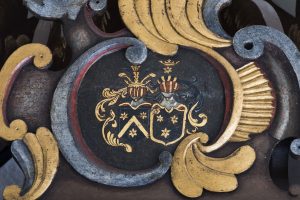
A noble title cost money, but then the young landlord could put his and his spouse’s noble shields on the newly restaured Nørlem Church – and in the nearby Gudum Church. Foto: Mads Krabbe
The Wandborg family move into Kabbel, 1733-1741
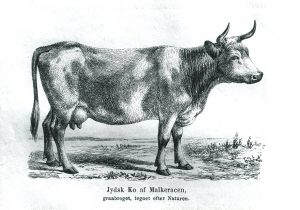
A good example of a solid jerky dairy cow from the 19th century. The fertile land around Kabbel gave good grazing and rich hay to both the manor house and the estate’s farms. Butter was as good as ready money. V. Prosch, Breeding and Care of the Cattle, 1885. Photo: V. Prosch, Kvægets Avl og Pleje, 1885.
Kabbel had no glorious past as a manor. Absentee, minor noble owners with financial problems were typical of its history until the middle-class Wandborg family from the district of Lemvig arrived in 1733. Kabbel was bought by two brothers, Laurids and Peder Wandborg, son of the late merchant, Jens Lauridsen Wandborg of Lemvig and Anna Maria Madsdatter, known as ‘Fru Kammerråds’ after her second husband, who had obtained an honorary title of chamberlain [da: kammerråd]. Fru Kammerråds had a reputation as an accomplished businesswoman, who had, for example, lent capital to west Jutland estate owners in return for mortgages in real estate.
Laurids Wandborg continued trading as a merchant in Lemvig, so it was Peder Wandborg who moved into Kabbel with his wife Maren. Maren was a merchant’s daughter from Aalborg, and both had grown up with a great flair for finance. After her husband’s death in 1737, Maren remained in Kabbel. The farm housed 82 cows, heifers and calves, a bull and a bullock, seven horses, as well as sheep and pigs. The unusually large herd of dairy cows was a rarity in west Jutland, where the focus was usually on bull and horse breeding.
But Kabbel had the advantage of its location near Lemvig, from where they exported butter to Hamburg. And it was not just the estate’s own butter they could export. The estate’s tenants paid their landgilde (annual rent in labour services or in money) in butter. In 1741, this amounted to an impressive 448 kg.

Kabbel looks a bit like a manor in this engraving, but is also presented as rather modest. However, the artist has captured some distinctive features of the garden with the peculiar fence in front. Trees may also have been a rare sight in West Jutland. Detail in Danish Atlas 1769.
Enterprise and progress, 1741-1759
When Maren died in 1741, her brother-in-law, Niels Jacobsen bought Kabbel at auction. He owned the largest grocery business in Lemvig and was married to one of Fru Kammerråds’s daughters. Enterprise, fear of God and charity sum up the following forty years or so, during which Niels Jacobsen, his wife Anna Maria Wandborg and their only son, Jens Wandborg, managed their properties in Nørlem Parish. They had capital, vision and contacts in a larger world. Fru Kammerråds had paid for Jens Wandborg’s education in Hamburg to learn trade and the German language.
Niels Jacobsen, followed by his son, Jens Wandborg, who took over the estate in 1759, dealt with both the agricultural operations and the buildings. They had ditches and dikes dug, so harmful water could be diverted, and the soil was marled with clay and lime.
A ‘fountain’ was installed for the kitchen and for watering the horses and bullocks. The old dilapidated buildings were demolished and new ones built, but an old Norwegian timber barn dating from 1639 was still intact, even though it had to be extended. Such was Kabbel in the 1760s.
Improvements to Kabbel, 1765
The family also established something very unusual for west Jutland : an orchard enclosed by a stone wall and a large vegetable garden. In 1765 they planted apple, pear, cherry and plum trees, which initially had to be protected in the winter with straw mats against hares, while in the vegetable garden they grew cabbage and potatoes, and even such luxury produce as asparagus. New fish ponds were established with carp, , bream, pike and perch, while in the Limfjord they fished for lavaret, eels and flounders.
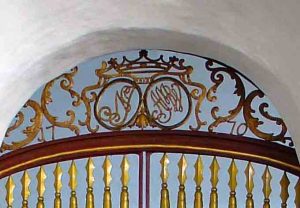
NJ and AMW are on the top of the grid gate to the graveyard in Nørlem Kirke. The merchant family Wandborg raised the somehwhat inconspicious manor to proper status. They rebuild some of the main building and increased their income through the specialized product of their peasants – butter. Photo: Erik Ring.
They also built a well-organised dairy with rooms for a tenant farmer, and in the garden the family could enjoy a very beautiful, brick-built pavilion with a vaulted ceiling, thatched with wood and a root cellar. Outside the garden there was a windmill for the manor’s own use. In the winter of 1779- they had fed 19 horses, 120 cows, heifers and bulls, together with 24 steers and 144 sheep. All had grazed in the summer, with the exception forty of the cows, who had to be stabled. Butter was still the estate’s main product.
Joy and sorrow, 1759-1761
As the owner of a manor house, it was possible for a middle-class man to purchase a noble title for himself from the king. Only then was it possible to marry a woman of rank. On 14 September 1759, Jens Wandborg received a distinguished patent of nobility. He was now 30 years old and could add “de Stiernhielm” to his name and promote his new status with a coat of arms. By way of a fee, he had to pay 1,500 rigsdaler for “pious purposes”, as it was stated in the authorisation. On 5 October 1759, Jens Wandborg de Stiernhielm married Christine Marie de Jermiin from the nearby manor of Ausumgaard. Her father had been awarded his patent of nobility in 1750.
In spring 1760, Christine Marie became pregnant and on 20 December gave birth to a son. According to the custom of the time, the newly born child was immediately christened at home with a view to being blessed at a later point in the church. He was christened Niels Jacobsen de Stiernhielm. Expectations were high. The continuation of the family was important, given all the rights and obligations that came with it, when a family occupied such a lofty position in the parish and town. With a new heir, the future seemed secure for the prosperous Wandborg family.
Three weeks later, the priest in Nørlem wrote in the church register: “On Friday 16th January 1769 we laid to rest the noble and highly born Mrs. Christine Marie de Stiernhielm (née de Jermin) who, after a hard delivery, followed by weakness and confinement to her bed, died at midnight between 5th and 6th January at the age of 19. On the self-same day we laid to rest Mr. Stiernhielm’s baby son, Niels Jacobsen, who was 3 weeks old. He would rather (after God’s will) follow his mother into death than live without her in the world. May God grant them a joyful and glorious resurrection.”
The two coffins were placed in Nørlem Church’s tower, which served as a burial chapel for the following ten years. Jens Wandborg grieved deeply and furnished the church as a memorial to his deceased wife and son. In 1780, he died without an heir.
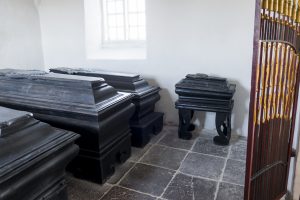
The small children’s chest is still in the tomb of the family in Nørlem church. The event makes one think of the salmon poet Thomas Kingo’s psalm from 1681, “Sorrow and Joy they walk in abundance, Happiness, Misfortune they come in a Row”. Photo: Mads Krabbe.
The last Wandborg at Kabbel, 1780-1793
Kabbel was sold to Jens Wandborg de Stiernhielm’s cousin, Hans Wandborg. Hans Wandborg was a man on the way up, and in 1768 he graduated as a Master of Law at the University of Copenhagen. He was the last of the Wandborgs at Kabbel and died on the estate in 1793. He was interred in the Wandborg family’s burial chapel in Resen Church.
The following year, his widow married a merchant, Morten Christen Aggersborg in Lemvig. He was a man of the future and, as the curtains closed on the 18th century, they also closed on Kabbel as a manor in the traditional sense of the word. In 1799, the manor sold off its copyhold farms. However, unlike many other places in west Jutland, the manor held on to its own land, the home farm. Kabbel was sold to a farmer, Christen Jensen Breinholt, thereby ushering in a new era at Kabbel – and in west Jutland. Now it was all about horse breeding and horse trading.
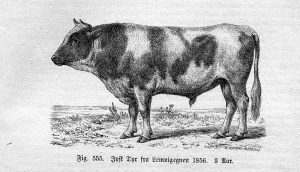
The West Jutland cattle were known from Thy to the marches and further on to the cattle markets in Hamburg. They were steers, ie. Castrated animals. They were driven south by road in large flocks, controlled by drivers and followed by carriages with cattle dealers. Engraving from ”Landbrugs-Ordbog for den praktiske Landmand”, 3. del, H-K, 1878.



